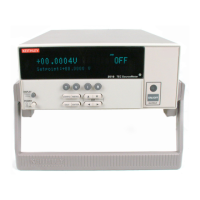Models 2510 and 2510-AT User’s Manual Connections 2-5
Sense selection
4-wire connections minimize the detrimental effects of lead resistance by sourcing the test
current through one set of wires (OUTPUT and INPUT F terminals) and measuring the
voltage across the device through a second set of wires (S terminals).
OUTPUT sensing
Sensing though the OUTPUT terminals is automatic with no user programming required.
To use sensing with OUTPUT connections, simply make 4-wire connections to the ther-
moelectric cooler as shown in Figure 2-2. Note that it is recommended that you use 4-wire
OUTPUT connections whenever the thermoelectric cooler voltage or resistance must be
accurately known.
INPUT sensing
4-wire sensing may be used for both RTD and thermistor sensors, but sense selection is
not automatic. The sense mode must be manually set when choosing a sensor type with the
CONFIG T or CONFIG R menus. See “Configuring functions,” page 3-3, for details.
NOTE 4-wire connections and 4-wire sensing should be used with RTD and thermistor
sensors with resistances <1k
Ω
to avoid errors caused by lead resistance.
Sensing considerations
Figure 2-4 shows a comparison of 2- and 4-wire sensing methods. In these examples, the
INPUT terminals are connected to a thermistor type temperature sensor, but the consider-
ations for RTD sensors and OUTPUT connections to the TEC are similar.
2-wire sensing
The 2-wire connecting method is shown in Figure 2-4A. To determine the sensor resis-
tance, the test current (I) is forced through the F+ and F- test leads and the resistance of the
thermistor being measured (R
T
). The Model 2510 then measures the voltage across the
thermistor through the same F+ and F- connecting wires and computes the thermistor
resistance from the measured voltage (V
M
) and the current as follows:
The main problem with 2-wire connections is the wire resistance (R
W
). Since the test cur-
rent (I) causes a small but significant voltage drop across the wire resistances, the mea-
sured voltage (V
M
) will not be exactly the same as the voltage (V
T
) directly across the
thermistor, and considerable resistance and temperature measurement error can result.

